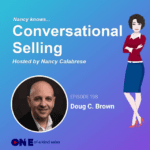by Marta Malyk | May 13, 2024 | Sales process, Sales Prospecting, Sales Tips
In the dynamic world of sales, success is often determined by a combination of strategy, skill, and ethical conduct. While there are countless approaches to selling, not all methods are created equal. Some practices can yield positive results in the short term but may harm relationships and reputations in the long run. Let’s explore the fine line between acceptable and unacceptable sales practices.
OK Practices:
Honesty and Transparency: Building trust is essential in sales. Being honest about product capabilities, pricing, and potential outcomes establishes a solid foundation for lasting customer relationships.
Active Listening: Understanding the needs and concerns of customers is crucial. Active listening allows sales professionals to tailor their approach to address specific pain points and offer meaningful solutions.
Value Proposition: Highlighting the value proposition of a product or service demonstrates its relevance to the customer’s needs. Focusing on benefits rather than features helps prospects envision the impact on their lives or businesses.
Relationship Building: Successful salespeople invest time in nurturing relationships with customers. This involves maintaining regular communication, providing support after the sale, and demonstrating a genuine interest in the client’s success.
Continuous Learning: The sales landscape is constantly evolving. Embracing a continuous learning mindset enables sales professionals to stay updated on industry trends, refine their skills, and adapt to changing market dynamics.
Not OK Practices:
Misrepresentation: Exaggerating product capabilities or making false promises to close a sale is unethical. While it may result in short-term gains, it damages credibility and can lead to negative word-of-mouth and potential legal consequences.
High-pressure Tactics: Pressuring customers into purchasing aggressive tactics or false scarcity creates a sense of distrust and can tarnish the reputation of both the salesperson and the company.
Ignoring Feedback: Disregarding customer feedback or failing to address complaints can alienate clients and damage relationships. Listening to concerns and taking proactive steps to resolve issues demonstrates a commitment to customer satisfaction.
Lack of Transparency: Hiding important information, such as hidden fees or contract terms, breeds mistrust. Transparency fosters open communication and ensures that customers make informed decisions.
Neglecting Ethics: Engaging in unethical behavior, such as bribery or kickbacks, undermines the integrity of the sales process. Upholding ethical standards is essential for maintaining trust and credibility in the eyes of customers and stakeholders.
While the sales profession is inherently competitive, ethical conduct should always remain a top priority. By adhering to honesty, transparency, and customer-centricity principles, sales professionals can build strong relationships, foster loyalty, and achieve long-term success.
by Marta Malyk | Nov 7, 2022 | Best Sales Practices, Cold Calling, Cold Calling Success, Cold Calling Tips, Sales, Sales process, Sales Prospecting
A quiz for you:
Communicating your expertise and product knowledge to your prospect leads to a successful sale:
1/ True
2/ False
I came across this question in a session with a world-class expert in the Sandler selling method. This is one that can spark a lot of debate.
I’m aware that many salespeople are trained to be product experts. In fact, product or service training may be the lion’s share of the formal training that they receive from their company. Often, salespeople are coached to share their knowledge in order to establish their expertise with a prospect. This might be because the business perceives that the offering is so differentiated that once a prospect fully understands it they will jump at the opportunity. So, an encyclopedic knowledge of the offering and the ability to communicate it is often perceived as a major sales success factor for a salesperson.
However, consider the problems that could arise with this approach. What if we miss something critical because we are so busy “communicating” about our offering? When we first meet with a prospect, I believe it’s important to let the prospect communicate with us. What are their current issues? Why are they even talking to us about our offering? What problems are they trying to solve? If we move into “presentation mode” without knowing the answers to these questions, we risk losing the prospect’s attention by not addressing their core concerns. In order to get at these concerns, we need to take the time to ask the right questions and then engage in active listening so that the prospect can communicate with us and so that we can internalize what they are saying. We need a two-way conversation and, particularly early in the discussion, it’s ideal if the prospect does most of the talking. This is where we learn what we need to know in order to confirm if they are a good fit for our solution and then close the sale.
So what’s my answer to this question?
False: I’ve concluded that product knowledge and expertise aren’t enough to close the sale.
My recommendations:
- Avoid getting into the “nuts and bolts” of a product presentation immediately with a prospect.
- Slow down and take the time to get to know prospects in order to learn what motivates them.
When you truly understand their situation, you can then start to use your understanding of your offering to highlight how your solution will make a real difference for them. In my experience, taking this approach will improve the likelihood of a successful outcome.
At One of a Kind Sales, we love to sell and are lifelong learners when it comes to selling. Cold calling is our specialty. If your business needs help with getting appointments with qualified prospects, give us a call at 908-879-2911.
by Marta Malyk | Oct 24, 2022 | Best Sales Practices, Closing Sales, Sales efficiency, Sales process, Sales productivity
As business owners, we all want to grow by winning new clients. But many of us find it difficult to “convert” new opportunities into paying clients. This leads to frustration.
In my 20+ years of experience as a sales professional, I’ve observed that many business owners meet prospects and then immediately move forward to “sell” without taking a pause and assessing what needs to happen next. They don’t actively manage the selling process. There are four actions you can take to help increase your sales efficiency.
Step 1—Talk to the Real Decision Maker
There is nothing more frustrating than discovering that you’ve walked through an entire sales process only to discover that your prospect needs to bring in another party who will ultimately make the decision. The step of confirming that your contact is the real decision maker is often overlooked. We get excited over the prospect of new business with a long-sought company and it’s easy to assume that our contact holds more power than they do.
Make sure you explore the company’s decision-making process with the person who is your contact. Be prepared to say you can only go so far in the process without having the ultimate decision makers involved. Your likelihood of getting to a commitment is greater when you speak directly to the decision maker(s).
Questions you can ask to move this along are:
- What is the decision-making process for services or products like mine?
- Who else will be part of the decision making?
- Are there other major stakeholders who would be involved in the decision?
Step 2—Ensure Your Solution is Relevant
It’s better to learn quickly if there is no current opportunity with a target company rather than to invest your time selling to someone who doesn’t need or value the solution you offer. Once you confirm that you have a relevant solution, take time to understand how the problem has impacted their business. This allows you to adjust your discussion to speak directly to their experiences. It may feel unnatural to not push to a close immediately upon confirming their need. But if you invest your time in this dialogue, your prospects may actually sell themselves. They are reminding themselves why they should be talking to you. And they realize that you are listening to them. This makes them more amenable to moving forward.
Ask the following questions:
- How has this problem affected your business? And for how long?
- What resources has this problem consumed? What did it cost you?
- What have you already done to address it?
Step 3—Seek Confirmation Along the Way
Throughout the discussion, make sure that you are getting mini buy-ins. Check for agreement at key points, ideally using open-ended questions. Don’t wait until the end of your presentation to ask their opinion. This way, you’ll be able to assess your prospect’s level of engagement, confirm their interest, and address potential objections as they occur. Moreover, this approach will ensure that this is a two-way conversation.
Use these prompting questions:
- How consistent is this with what you experienced?
- What are your thoughts on this?
- How does this sound to you?
Step 4—Let Your Personality Shine Through
Throughout the engagement, never forget that “people buy from other people.” Let your personality shine through! If you are staying true to steps 1 though 3, your empathy for their situation will be apparent and you’ll build credibility and trust. Ultimately, you want your prospects to feel good and look forward to working with you.
Getting to the Close
Using this approach, the natural outcome of a discussion between you and your prospect is to move to a proposal.
- You are talking to the right person.
- You know they have a problem that you can solve.
- They’ve validated for themselves that they have this need.
- They know that you have a deep understanding of their situation.
By the time you get to this point, your prospect should have reached the unavoidable conclusion that your solution is just what their business needs.
Here’s the final piece of “magic”—if you’ve taken these steps, once you are ready to close, you can simply ask, “What would you like to happen next?”
When you get your next opportunity, take a step back, consider this guidance, and see what happens.
If your business is facing sales-related challenges, please reach out to us at 908-879-2911. At One of a Kind Sales, we are experts in sales and we particularly love cold calling. We look forward to speaking with you!
This article, written by Nancy Calabrese of One of a Kind Sales, originally appeared in The Bottom Line, No. 3: 2022, the quarterly newsletter of NJAWBO, New Jersey Association of Women Business Owners.



